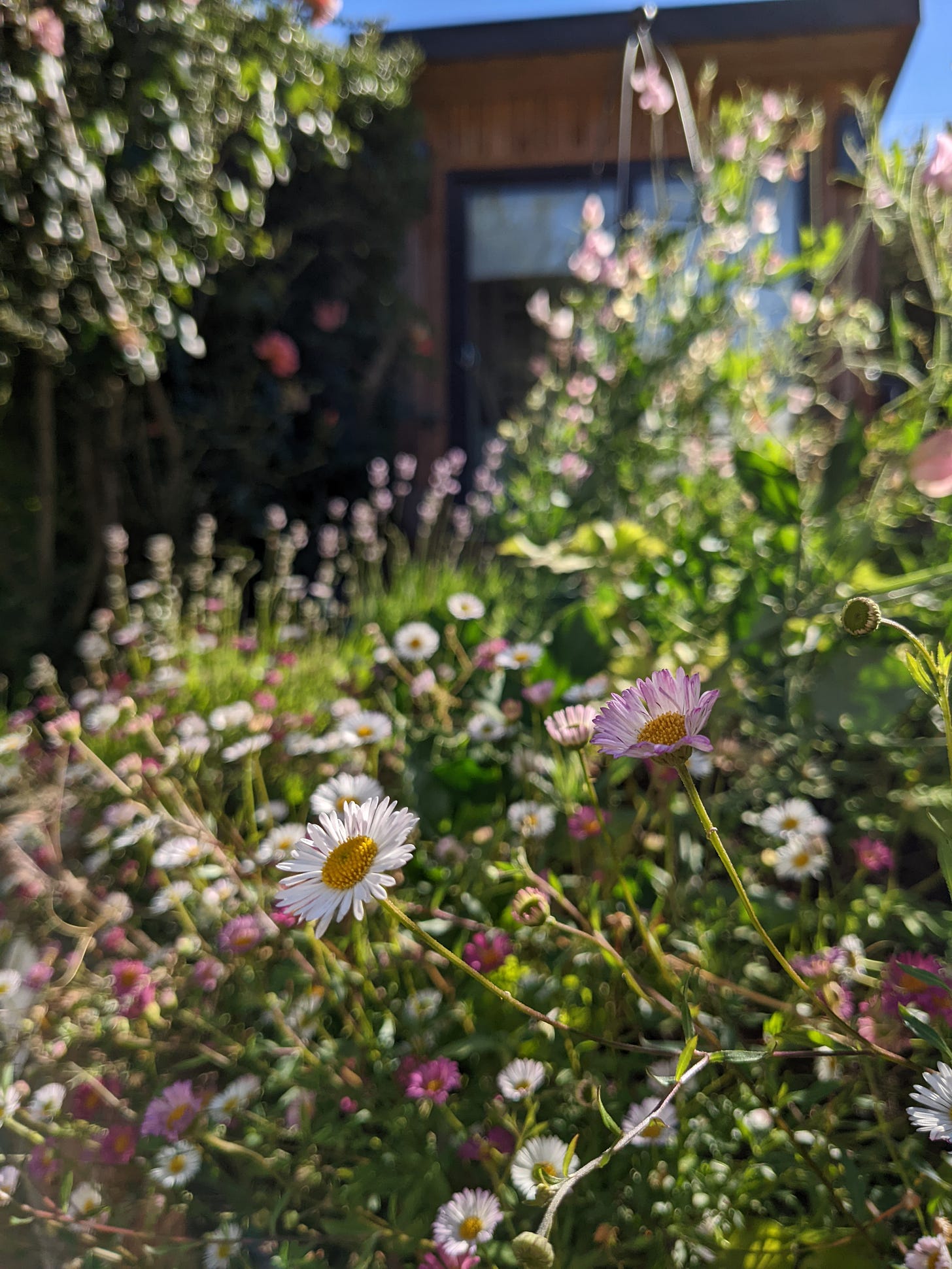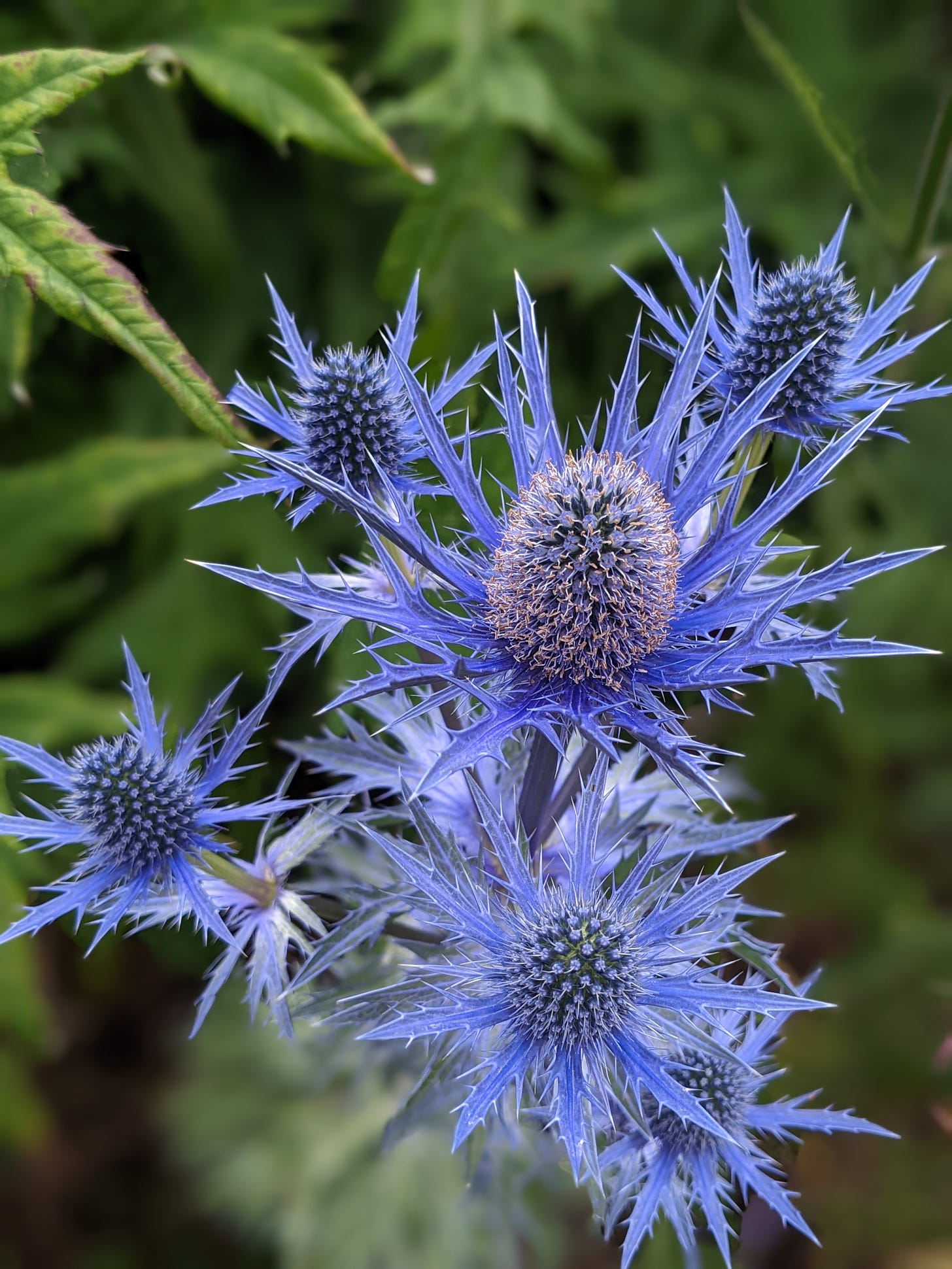July's high summer to the deepest past…
Cottagecore to coastal-prairie, smelling the roses, and... dinosaur food!
In this issue…
What’s growing this month: the spring-summer changing of the guard
From the garden office: I’m out of the office for the summer!
Greenhouse guest: Garden-to-table traditions and prehistoric plantlife with Middle Grade and Young Adult author Skye Melki-Wegner
Hi, July!
And, just like that, we’re in the second half of 2022. Whether you’re in the depths of winter in the southern hemisphere, or the height of summer (as we are in Scotland), I hope you’re able to take the time to figuratively or literally stop and smell the roses.

Out in the garden, everything is finally hitting its stride… including the weeds. The jobs ramp up to where it feels like every day could be justifiably spent pruning or tying-in or battling against the couch grass’s tireless invasion of the raised beds. Alas, my day jobs keep me tethered to my desk.

By mid-July, the changing of the guard has begun. The softness of spring wilts, but the stalwarts of summer aren’t yet at the height of their powers. It’s an awkward phase, a sort of gawky adolescence in the gardening year that I know many UK gardeners lament. It’s only my second year with this patch of ground, though, so I still have the hubris determination to think I can smooth the transition next year. Spare moments between chores and bill-paying work are spent wandering the paths, scheming and planning.
This anticipation, a desire to fill the gaps, to make use of every day, to be efficient, has long been reflected in my writing practice. But it’s an urge I’m actively trying to examine and, at times, resist.
Right now, I’m between projects. The world and characters of one book are fading to a fond memory with the tulips of spring. The new project is still coalescing. The seed has germinated and been agent-approved. The shoots are unfurling. But there’s much work to be done before I’ll be rewarded with flowers, let alone fruit.

So, I pace the paths, mulling over gaps in planting as I wrestle with plotholes and build character profiles. Until, finally, the ‘second stage of summer’ bursts onto the stage in the garden, star perennials and a chorus line of annuals, the latter almost smug at making me await their debut performance.
The cottagecore white-and-pastel palette of spring has been replaced by deep blues and dreamy silvers in an area that catches the afternoon sun, rich magenta and velvety purple in another. From now until the autumn leaves fall, it’s coastal-prairie vibes. Stiff-stemmed spires, spiked and sculptural, yet also flexible enough to sway in the breeze.
It might just be my favourite time of year.
Back at my writing desk, I’m reminded to enjoy this nascent stage of creating. To revel in this space where anything is possible and nothing is off limits. To take advantage of the opportunity to draw breath, or better yet, take a real, proper break. A holiday.
Which is exactly what I intend to do. I hope you can do the same in the not-too-distant future (go smell the roses!).
But before I go… interview time!
Greenhouse Guest: Skye Melki-Wegner
This month, it’s my pleasure to introduce a wonderful YA and MG author, whose upcoming trilogy would have been my ultimate obsession when I was a kid. Wings of Fire meets Jurassic Park? Hell yes!
One glance at the cover and knew I absolutely had to invite Skye to The Greenhouse. I mean, look at that prehistoric plant goodness, would you?
<happy sigh>
Right, where was I? Ah, yes! Time to introduce my fabulous guest:
Skye Melki-Wegner (she/her) is an author from Melbourne, Australia. As a child, she started writing as soon as she could hold a pen — and soon her notebooks overflowed with dragons, pixies, wizards and various magical shenanigans. After graduating with an honours degree in law, she decided to pursue her passion and prioritised writing fantasy adventures over pursuing a legal career.
Her YA fantasy novels include the Chasing the Valley trilogy and The Hush. Her first Middle Grade trilogy, The Deadlands, will be published in 2023.
You can find Skye at her website, or on Instagram and Twitter.
Welcome, Skye! I’m so happy to have you here in The Greenhouse. I’ll start with my usual icebreaker – what’s your fave plant?
I absolutely adore giant sunflowers; they look so cheerful and they’re so much fun to grow. One summer, I grew a patch of sunflowers in my parents’ backyard. It was such a joy to watch them sprout – and to watch them outgrow me!
I’ll confess, my friends know all too well that yellow is quite low in the colour pecking order in my garden. But after last year, when sunflowers self-seeded from the bird feeders, I became a convert! I completely agree with you, watching them grow is amazing, and then when the bees find them in late summer, and in early autumn the birds have a feast of the seeds—they’re just so much fun.
I’m so glad you mentioned family gardens, too! I’ve been lucky enough to sample some of your wonderful plant-based recipes on writing retreats, and I’d love to hear more of the history there…
My grandpa lived in an ordinary suburban house in Melbourne, but his garden was like another world. He grew lemons and olives, figs and persimmons, pears and plums, veggies and herbs, apricots and oranges… basically, anything he could fit into the space available! One highlight was his apple tree, which he grafted to grow three different varieties of apple.
Growing up, lunch at my grandparents’ house was generally an amazing Lebanese feast – and Grandpa would always start the meal by explaining how each ingredient came from the garden. (‘You like that kousa? Out of the garden!’) It was such a point of pride for him and his enthusiasm was truly infectious.
I would have loved to have met your grandpa. What wonderful, cherished memories—thank you so much for sharing them. There’s something magical about growing food yourself and then getting to share it with your nearest and dearest. I dream of one day creating a writing retreat venue that’s garden-to-table, where all my friends can come and write and enjoy organic fruit and veg… but that’s a bit of a far-off fantasy.
How about you? What role do plants currently have in your life?
I currently live in an apartment, so my ability to garden is quite limited. Outside my front door, I have grown a few small plants in pots – including some flowers, a tiny mandarin tree (nicknamed ‘Mandy’) and a mini lemon tree. During the covid lockdowns in 2020-2021, these plants were a real lifeline.
In the near future, I hope to move to a home with outdoor space. It’s my dream to have my own veggie patch and fruit trees like my grandparents. I love the idea of serving meals to my family featuring homegrown produce. Just as my family passed down a love of gardening to me, I hope to pass it down to my future kids.
I couldn’t think of a better family tradition, honestly.
What about plants in your creative work? Have they had a role in your stores?
My upcoming MG trilogy (The Deadlands) is set at the end of the dinosaur era. In this trilogy, plant-life is a vital element in establishing mood and setting. My protagonists are all herbivorous dinosaurs, so they rely on foliage to survive in an unforgiving world.
The trilogy revolves around warring dinosaur kingdoms, fighting for the last remaining habitable territory in the aftermath of the Fallen Star. This contested territory (rich with conifers and ferns) stands in stark contrast to the Deadlands: a stark desert, bereft of plants and water. As such, plants are absolutely vital as tools of survival – and as motivation to wage war. My heroes are a gang of plucky young herbivores, so their need for foliage propels many risky decisions and forces them into dangerous situations.
One of my P.O.V. characters is an anurognathid: a tiny pterosaur who works as a mercenary spy in the war. For her, certain plants trigger memories of her grandmother’s nest. I used these plants to conjure moments of soft nostalgia, which stand in stark contrast to the unforgiving world she lives in – and the ruthless choices she must make.
When drafting, I did try to consider era-appropriate plants where possible. For example, I generally described trees as ‘conifers’ and opted for fern prairies rather than grasslands.
However, I must confess that I lean more towards creative license than historical accuracy! If the plot called for luminescent fungus or sweet moss, I just threw them in and hoped for the best. I also invented several fictional plants for this series, including thorns with sedative properties and toxic vines. These add to the sense of danger and adventure as the dinosaurs fight to survive.
From what I know of plants (and what I know of what we still don’t know about plants), your imagination is pretty much the limit. Same with fungi. After all, there’s over 100 species of bioluminescent fungus, and many of the species we have today evolved before the dinosaurs, so my bet is you’re safe with at least some of that creative license!
Now, I know you’ve got a million things to be doing right now, including drafting and editing the later books in the trilogy. So, before we say our farewells, do you have any plant-related favourite books or films?
This is such a corny answer – but when I was a little kid, I was obsessed with the film Fern Gully. Like many kids who grew up in the 90s, I can probably thank this film for my greenie tendencies! I adored the magic of the rainforest setting and how the fairies were so attuned to the needs of the forest. (And besides, how can you go past Robin Williams as Batty?)
Now that brings back childhood memories…
Thanks so much for joining us, Skye! I cannot wait for The Deadlands.
Dear readers, you’ll have to keep your powder dry until early next year, but in the meantime, you can pre-order it from your favourite bookstore (surprise gifts from your past self are The Best!) and add it on Goodreads!






